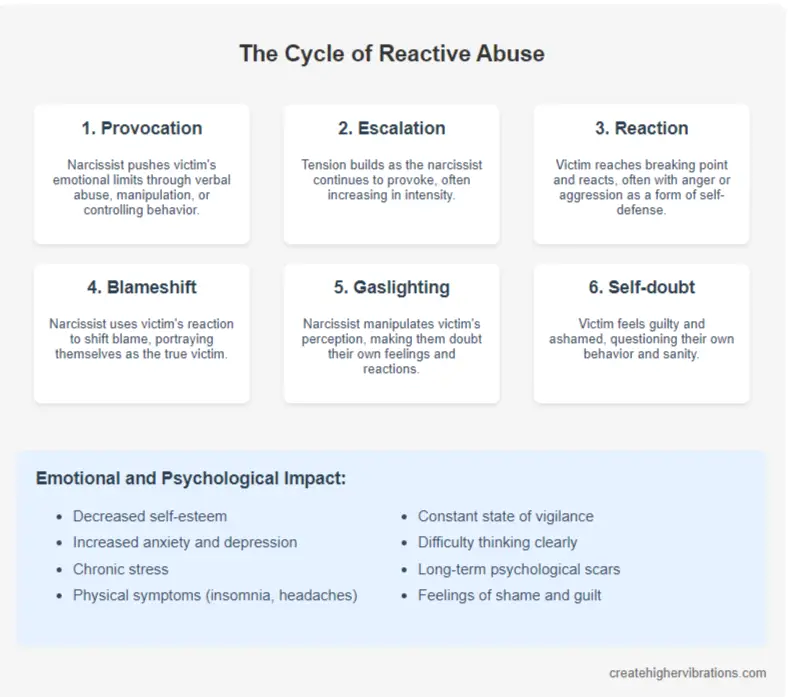Narcissists Set You Up For Reactive Abuse, (What You Need To Know!)

Narcissists are known for their manipulative behavior, and one of the most harmful tactics they use is reactive abuse. They push you to your emotional limits until you react. Then they use that reaction to claim that you are the problem.
This dynamic happens in many abusive relationships, leaving victims confused and doubting their sanity.
In this article, I’ll dive into how reactive abuse works. I will explain the emotional and psychological impact it has. I’ll also discuss how you can protect yourself from falling into this trap.
What Is Reactive Abuse?
Reactive abuse occurs when a victim, after being provoked continuously, lashes out in self-defense. This response, often labeled as reactive aggression, is a natural reaction to constant mistreatment and manipulation.
Studies show that this kind of aggression often stems from a fight-or-flight response in situations of power imbalance. Narcissists use this tactic to shift the blame, gaslighting their victims into thinking they’re at fault for their reactions.
Prevalence of Domestic Violence
According to the National Domestic Violence Hotline, nearly 3 in 10 women and 1 in 10 men in the United States have faced rape. They have also encountered physical violence. They also faced stalking from an intimate partner.
Over 35% of women and 28% of men have experienced these forms of violence at some point in their lives. In abusive relationships, victims of reactive abuse often face gaslighting.
They encounter manipulative behavior and toxic dynamics. These factors keep them trapped in a cycle of emotional manipulation.
Emotional and Psychological Impact of Reactive Abuse
The emotional toll of reactive abuse can be devastating. Victims often experience a sharp decline in their self-esteem, increased anxiety, and depression.
The chronic stress of living in such a high-tension environment can lead to physical symptoms like insomnia and headaches. It can also cause digestive issues.
Reactive abuse causes a constant state of vigilance. This makes it difficult to think clearly. It also makes it difficult to act rationally in the face of provocation.
Long-Term Emotional Damage
Victims of reactive abuse often feel ashamed and guilty for their reactions, even though they were provoked. The abuser’s constant manipulation makes it easy to forget that the context of the situation matters.
Victims are often left questioning their sanity, and this self-doubt only deepens the psychological scars of the abuse.
Behavioral Patterns: Why Narcissists Use Reactive Abuse
Narcissists use reactive abuse because it allows them to maintain control and avoid accountability. By provoking their victim to react, they gain the upper hand in the situation. It’s all part of their larger strategy to manipulate and dominate the relationship.

Reactive Aggression: A Natural Response
Research has shown that reactive aggression is a common response to repeated provocation, especially in situations where there is a significant power imbalance.
In these cases, victims feel trapped and lash out as a means of self-defense. This aggression is often used by the abuser to justify further manipulation, reinforcing the cycle of abuse.
Manipulative Tactics: Gaslighting and Blameshifting
Abusers often use specific triggers to provoke their victims into reacting emotionally. These triggers can be personal questions, violating boundaries, or public humiliation.
Once the victim responds, the abuser manipulates the situation, using tactics like gaslighting to make the victim doubt their reality. They may record the victim’s outburst or tell others a distorted version, painting themselves as the victim.
This reversal of blame isolates the victim, making it harder for them to recognize the abuse and defend themselves.
Gaslighting in Action
In the earlier example of the daughter and her father, the father will later claim that she overreacted. He will deny any wrongdoing on his part.
He may even tell others how “unstable” she is, manipulating the narrative to portray himself as the victim. This is a textbook example of how narcissists twist reality to maintain control.

Breaking the Cycle of Reactive Abuse
It’s difficult to break the cycle of reactive abuse, but it’s not impossible. The first step is recognizing the pattern. You must understand that your reactions are sustained provocations. They are not a sign of personal weakness.
Setting Boundaries in Toxic Relationships
Establishing boundaries is essential in dealing with narcissistic abuse. It’s important to recognize when you’re being manipulated and remove yourself from situations that push you to your emotional limits.
Setting clear boundaries can prevent you from reaching the point of reactive aggression. However, it’s often easier said than done in an abusive relationship.
The Importance of Support Systems
Building a strong support system is crucial for those enduring reactive abuse. It can be a trusted friend, family member, or therapist. Having someone to talk to can help you process your feelings. This support can help you regain control.
Seeking Professional Help
Professional counseling or therapy can be a lifeline for those caught in the cycle of reactive abuse.
Online platforms like BetterHelp and Create Higher Vibrations create accessible therapy options. They allow you to connect with licensed professionals who can help you develop strategies for coping with the abuse.
This is especially important for those who do not have access to in-person therapy due to logistical or financial reasons.
Subscribe to Create Higher Vibrations!
Get Inspiration and Practical advice straight to your inbox.
Understanding the Role of Power Imbalance
In abusive relationships, there’s often a significant power imbalance. This imbalance makes it difficult for the victims to stand up for themselves.
Narcissists thrive on this imbalance, using it to control every aspect of the relationship. They manipulate their partner’s emotions, making them feel inferior and helpless.
Identifying Abusive Patterns
Recognizing the signs of reactive abuse is a critical step in breaking free from an abusive relationship. Watch for patterns of gaslighting, blameshifting, and emotional manipulation.
If you constantly apologize for your reactions, it can be because you were provoked. This is a sign that you are caught in a cycle of reactive abuse.

Healing After Reactive Abuse
Healing after reactive abuse involves a multi-faceted approach, combining emotional, psychological, and physical recovery strategies.
Here are detailed steps that I use with clients to help them begin to move forward:
1. Acknowledge the Abuse and Its Impact
Understanding that your reaction was provoked is the first step toward healing. Recognize that your actions were part of a defense mechanism, not a reflection of your true self.
Victims often feel guilt and shame after reacting to sustained abuse. It’s essential to remember that this is a result of manipulation tactics, not a moral failing.
2. Seek Professional Support
Therapy is critical in recovering from reactive abuse. A mental health professional can help you process the trauma, develop coping strategies, and regain your sense of self-worth.
Cognitive-behavioral therapy (CBT) can be particularly effective, helping you identify and break unhealthy thought patterns. Online therapy platforms like BetterHelp offer accessible and affordable support for those who cannot attend in-person sessions.
3. Rebuild Self-Esteem
Abuse, especially narcissistic or manipulative behavior, often erodes your self-esteem. Rebuilding it takes time, but practicing self-compassion is key.
Start by acknowledging your feelings without self-criticism, and practice self-care routines like mindfulness and meditation to nurture positive self-regard. Activities that bring joy and fulfillment can also aid in restoring your sense of self-worth.
4. Develop Healthy Boundaries
Setting and maintaining boundaries is essential for emotional and mental well-being. These boundaries protect you from future manipulation and reinforce your autonomy.
Saying “no” to toxic relationships and behaviors is a critical step in moving forward. It’s important to clearly define what is and isn’t acceptable, and to communicate these boundaries assertively.
5. Create a Safety Plan
If you’re still in contact with the abuser, having a safety plan can help manage future interactions. This can include physical safety measures, and strategies to avoid engaging emotionally when provoked. The aim is to prevent yourself from being drawn into reactive behavior again.
6. Build a Support Network
Surrounding yourself with supportive friends, family, or a therapist is crucial. These individuals can provide validation, emotional support, and practical advice as you navigate the complexities of healing.
Joining support groups, either online or in-person, can offer a safe space to share experiences. You can gain insights from others going through similar struggles.
7. Focus on Personal Growth
Reclaiming your life after reactive abuse involves rediscovering who you are outside of the abusive relationship. Focusing on personal growth through hobbies, education, or new experiences can help you regain a sense of purpose and direction. Set achievable goals and celebrate small victories to reinforce your progress.
8. Practice Mindfulness and Emotional Regulation
Mindfulness and emotional regulation techniques can help you manage anxiety, stress, and triggers that may arise from past abuse.
Mindfulness meditation encourages staying present, while emotional regulation helps you maintain control during stressful situations. These practices can empower you to respond calmly instead of reactively.
9. Challenge Negative Thought Patterns
Reactive abuse often leads to distorted beliefs about yourself. Combat this by actively challenging negative thoughts and replacing them with more positive, empowering beliefs. Techniques like journaling can help you track and transform these thoughts over time.
10. Allow Time for Healing
Healing from reactive abuse is a gradual process, and it’s essential to be patient with yourself. Recovery takes time, but with each step, you reclaim more of your emotional and mental freedom.
By combining these strategies my clients begin to break free from the cycle of abuse. They begin to rebuild their self-worth and reclaim control over their life.
Final Thoughts
Narcissism reactive abuse is a deeply damaging tactic used to gain control and avoid accountability. By provoking you into reacting, they shift the blame and manipulate the situation to their advantage.
By understanding the cycle of abuse, you can break free from this toxic dynamic. Build a strong support system. Seek professional help.
Know, you are not defined by your reactions to abuse. With the right tools and support, you can reclaim your power and heal from the emotional damage.



